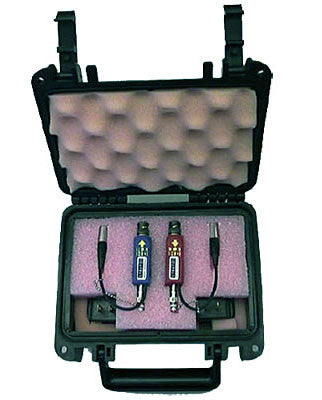Stratos HD VMC Video Media Converter Kit (Transmitter, Receiver, Power Supply in Rugged Case)
Stratos HD VMC Video Media Converter Kit (includes Transmitter, Receiver, Power Supply in Rugged Case)
VMC Video Media Converter modules offer extended distance over singlemode fiber for high-speed serial digital video links for multi-protocol HD/SD/DVB/ASI video applications with data transfer rates up to 1.485Gbps.
Product Features:
- Rugged Die Cast/Over Molded Construction
- Rugged ST Simplex Optical Interface with Dust Cover
- Transmitter: Line Equalized 75ohm BNC (male) Simplex Electrical Interface
- Receiver: Re-clocked/Line Driven ohm BNC (male) Simplex Electrical Interface
Download Product Spec Sheet:
- Stratos HD Video Media Converter Transmitter Spec Sheet (PDF)
- Stratos HD Video Media Converter Receiver Spec Sheet (PDF)
Product Description:
Stratos Lightwave converters meet SMPTE protocols 259M, 292M, 305M and 310M and will operate correctly and reliably from 19.4Mb/s to 1485Mb/s. They also support DVB-ASI operation. These converters are approximately 4in long by 0.75in high and 0.75in wide, and they are equipped with a 75‰ BNC connector on one end and an ST simplex fiber-optic connector on the other end. Using nine-micron, single-mode fiber-optic cable, they provide a typical link distance of 15mi at 1485Mb/s.
The devices fully meet or exceed all SMPTE specs at distances of 3mi at 1.485Gb/s and 6mi at 270Mb/s. The converters use custom optics, mechanical engineering and controlled impedance circuit design technologies for high-end telecom and data-com optical transceivers that operate at speeds of 2.5Gb/s or greater. The units are cost-competitive with other, larger converters while providing high reliability and high-quality video performance.
The small size of the units allows their use virtually anywhere directly on cameras and equipment, in the middle of a cable run or in rack-mount panels. They are contained in rugged, die-cast metal housings overmolded with a compliant, nonconductive elastomer. This packaging can withstand rugged handling and provides high reliability in the field.
Simplex transmitters and simplex receivers are available. The transmitter (in a red-colored housing) features built-in line equalization for signal integrity with various lengths of attached coax. The receiver (in a blue-colored housing) features signal re-clocking for all SMPTE 259M and 292M rates and 75‰ line-driven electrical outputs to support significant coax cable runs. Re-clocking provides random jitter control and allows broadcasters to use the receiver remotely in the field.
The different housing colors of the transmitter and the receiver reduce the chance of installation errors caused by personnel with minimal technical background or by knowledgeable personnel in a fast-paced, on-location event. A multi-color LED performance indicator, visible on the outside of the unit, provides a clear indication of go/marginal/no-go link status. This helps ensure reliable in-field monitoring, whether or not the user has any significant technical knowledge.
These devices include a digital-diagnostics interface (DDI) for high-reliability applications such as live video feeds or uplinks. DDI-monitored parameters include device temperature, device power-supply voltage, received optical power (receiver only), laser bias current (transmitter only) and transmitted optical power (transmitter only). DDI also offers alarm flags to warn when specific operating conditions exceed the device's parameters. An LED on each unit indicates these data, which can be accessed through the four-pin connector. The connector also provides DC power to the device, which can operate over a wide power supply voltage range of 4.5VDC to 16VDC.
Other devices and equipment that support these video media converters include universal 110V/220V wall-plug power adapters, a single unit in-line DDI interface box and a 1RU shelf, which holds 18 converters for rack-mount installations.
These video media converters facilitate the transport, processing and display of HDTV signals over significant distances, without loss of signal quality. They allow an existing infrastructure of coax-based video equipment to interface easily with fiber-optic cable. Because the units are small and self-contained, they eliminate the need for installation in equipment racks, providing flexibility in deployment.


